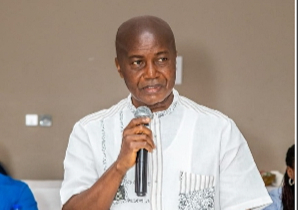Opinions of Thursday, 22 March 2012
Columnist: Baffour, Robert A.
Embarking on Applied Research to incorporate Cultural
, Life Style and Environmental factors in Roadway Projects in Ghana.
Dr. Robert A. Baffour, Vice President, Ghana Telecom University College, Accra, Ghana
It appears lack of research in Ghana is resulting in copying solutions from other parts of the world that may not necessarily be applicable to our part of the world. Today, for the sake of aesthetics values, most homes in the country use sliding glass windows. These windows typically found in the temperate part of the work are designed to prevent inside and outside conditions from interacting. For such places, the inside comfort is established by using central heating or cooling systems. It works perfect. In Ghana, heating is not needed all year round. The central cooling technology is not common in Ghana. Even if available, most homes may not be able to afford the cost of using such systems. The question is, why will people in a 30 degree Celsius country use an engineering solution designed and implemented for a zero degree Celsius country? It simply does not make any engineering sense. The cost of basic research is high. It is therefore appropriate to look at some of these solutions through the concept of applied research. Such research takes into considerations several local factors before their applications.
While there are several areas in the country where engineering solutions have been copied blindly, the focus today is the way highway and transportation projects are executed in Ghana. Three key elements are considered here: 1) the need to incorporate the cultural elements into our design and implementation of roadway projects, 2) the need for sustainable design solutions and 3) the need to insist on product quality and safety in the design and construction of road projects.
1. Incorporating Culture and lifestyle in the design and construction of roads in Ghana.
Reports from local media indicate that at least 14 people have died since the commission of the George Walker Bush highway in Accra. This beautiful and heavy volume-carrying road is an extension of the original Kwame Nkrumah motorway which was conceived, planned and implemented originally as a rural highway to link Accra and Tema. There were no communities between the two cities that needed access from the road. Today the story is different. The entire stretch of the Malam- Tema Motorway can be classified as an urban highway. The problem though is, while the function of the road had changed from rural to urban, inter-parcel access is limited. Transportation planning expects in Ghana and those who plan for Ghana should realize that the traffic stream mix in Ghana is very different from what you will find in other parts of the world. Like Holland where bicycle forms part of the modal mix, here in Ghana, Walking forms part of the mix and hence the design for inter-pacel access should consider the use of the legs as part of the transportation modes.
Ghanaian pedestrians do not obey the rule of dedicated pedestrian crossing areas. People cross anywhere, and anyhow. In addition to that, there are Pedestrians always use their own calculus of Newtonian mechanics to predict the speed of the oncoming vehicles and how fast they can run to cross. Even though these roads are technically considered as urban roads and the speeds should be limited to say 90km/h, one can easily find drivers cruising at such speeds at 100 to 140 km/h. Such speeds obviously cannot support the safety of child carrying mothers crossing the roads. Since the road is designed to solve a specific problem, the speed cannot be reduced to the level of a two lane highway. That will defeat the purpose and hence there is the need to invoke some cultural and lifestyle factors in developing appropriate solutions to our unique problems.
Preventing unnecessary crossings: The only way to prevent Ghanaians from crossing roads at unwanted locations is simply to restrict access. There are several locations in Accra where pedestrian simply ignore dedicated pedestrian crossing and cross the roads at several dangerous points. At the same time, the design and implementation of such crossings should incorporate the behavior of the Ghanaian pedestrian. The current design of pedestrian crossing on the Bush motorway is simply inadequate. It appears the design is using American concept where there are virtually no pedestrian on such roads attempting to cross. The situation in Ghana is different. Trotros and Taxis stop almost anywhere they want and their occupants need access to their facilities from where they are dropped. A quarter mile to about half a mile between crossings will not work for locations like Abeka with such a huge population crossing the roads for all kinds of reasons. Restrict access perhaps by raising the dividers but increase the access points.
The agency that has jurisdiction over these roads (Ghana highway authority or the Department of urban roads) should take a serious look at how to block access on such roads to allow the road to function properly and also provide pedestrian with adequate access to the adjoining properties. Raising the medians, education and arrest may be possible solutions but the solution that may work well with possible economic benefits to the municipality may be the model that one can find in places like Seoul, South Korea where the entire underground of such location are developed into shopping centers with various access points on the road. Perhaps, allow private developers to develop such malls in such critical locations will be idea. The chaotic Kwame Nkrumah Circle trading area can benefit from such a solution. The beauty is, the current location can then be used to develop affordable housing or office complex to support economic activities in the city.
2. Applying Sustainable solutions to roadway lighting.
Judging from what persist in the country now, one can easily predict how the streets light along the new George Bush highway will fare a year from now. Simply put, the lamps will not be providing any lights to the driving public. The question is, is it not surprising to see that while the rest of the world is moving towards sustainable energy solution in their road projects, the new George Bush highway will be commissioned in 2012 with roadway lighting connected to the national grid? Is there any reason why solar energy was not used to provide lighting to this stretch of road? Is the Electricity Company of Ghana (ECG) not currently bleeding due to excess demand? We need to think beyond today and move towards tomorrow.
3. Quality and Safety
Some sections of the Circle-Nsawam road around Achimota-Dome-Taifa is nothing but dead zones. The roads are currently in vertical layers with no guards preventing a stray vehicle from falling from one layer to the other. The current situation is very catastrophic waiting for an accident to happen. The current situation does not satisfy any engineering practice and I am wondering who is making the decision to allow drivers to use these sections. It is very clear that no one takes the safety of Ghana drivers and the passengers into considerations. A swift treatment of this danger is needed before lives are lost.












